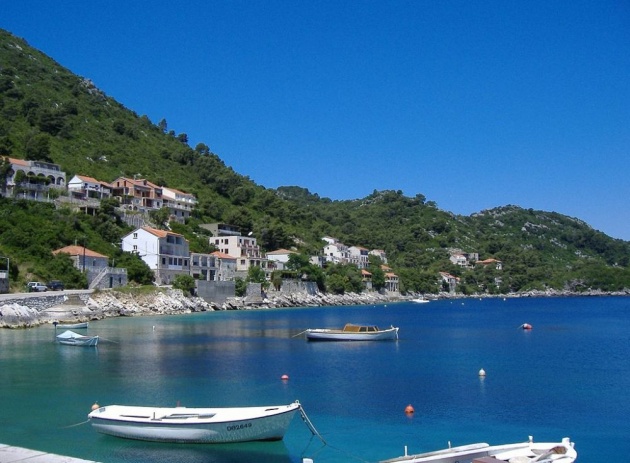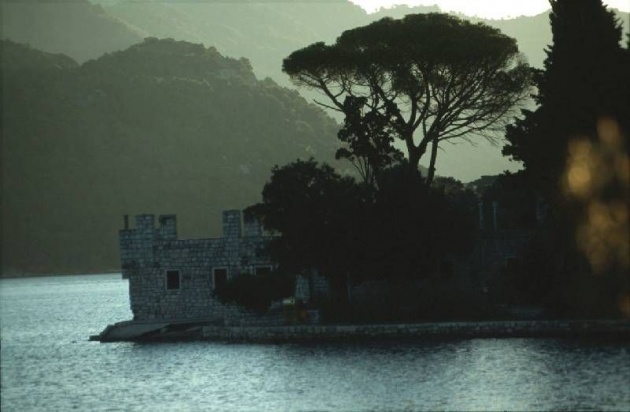Mljet (in Croatian: Mljet, in Italian: Meleda, Latin: Melissa) is an island in Croatia and the Adriatic Sea with about 98.01 km ² and 1111 inhabitants (2001 census).

Mljet is south of the Pelješac Peninsula, which separates the Mljet channel. Its length is 37 km, the average width of 3.2 km. It is of volcanic origin, with many ravines and gorges, of which the largest, Babino Polje, connects the north and the south of the island. Place, the main port in the north, is a port of call for cruise ships. Mljet has a hotel - The Odisej - in the northwestern part of the island.
The northwest part of the island includes a large saltwater lake, and a small island within it. It is national park since November 12, 1960.

The ancient Greeks called the island "Melitta" ("Honey"), and along ds centuries evolved to become the Slavic name, Mljet (pronounced Mliet) and its dual Latin Meleda.
About 72% of the island is covered with forests. The geology of the island consists of limestone and dolomite forming ridges and slopes; the few depressions on the island of Mljet are below sea level and are known as Blatine ("mud lakes") or slatine ("salt lakes"). During the rainy season, the clay ponds are filled with water, but during the summer this becomes brackish.
The climate is Mediterranean, with average temperatures in January and 9 ° C in July near 24 ° C.

history
The history of Mljet was described by Greco-Roman geographers, who wrote the first records and descriptions. The island was first described by Cílax Carianda of the sixth century BC, although this island also appears in the Periplus of Pseudo-text Cílax. In both texts is called MeLite and with the support of Apollonius of Rhodes. Agatemero and Pliny the Elder called the island Melita. Agesilaus of Anaxarba, who was governor of Cilicia, was exiled to Mljet by the Roman Emperor Septimius Severus (145-211).
Mljet is mentioned around 950 by the Byzantine emperor Constantine VII Porphyrogenitus. The island was strongly disputed by the Croatian nations Pagania and Zaclúmia until the unification of the Kingdom of Serbia in the twelfth century.
Mljet was considered as the island "Melita" in which shipwrecked St. Paul (Acts 27: 39-28: 11) and this hypothesis in the tenth century, the Byzantine Emperor Constantine VII. This contradicts the opinion that St. Paul was shipwrecked on the Mediterranean island of Malta. There are ports in honor of Sao Paulo on both islands.

The Benedictines of instinct (in Puglia, southern Italy) became the feudal lords of the island in 1151, having reached the Monte Gargano in Italy. Were to the coast in cala Sutmiholjska and the Serbian Prince Desa of Vojilhavljevic camera built and offered them the Church and Monastery of Santa Maria in the islet in Big Lake (1187-1198). Pope Innocent III issued a church consecration of the document in 1198.
The island rock rose under Nêmania Stephen domain in 1166-1168. In 1222, his son Stephen I of Serbia, the first Nemanjić crowned King of Serbs, has given their land of monasteries and granted the church in Krkar the Benedictine Order of Mljet. After serving as a last Serbian maritime bastion, Stephen Uroš V of Serbia emperor offered the island Ferry I in 1357.
The Benedictines renounced their rule over the island in 1345, leaving only a third of the earth. The island has a statute and a municipality in Babino Polje. It was formally annexed by the Republic of Ragusa in 1410. According to the contract with the Benedictines, the municipality had to pay 300 annual perperas.
In the sixteenth century, the monastery was the center of the Congregation of Mljet (Congregation Melitensem or Melitanam), the set of all the monasteries of Benedictine monks under the Ragusa Republic. The first president of the Congregation was Mauro Vetrani, the abbot of the Mljet monastery and famous poet. Another great poet was not abbot - Ignatius Giorgi in the eighteenth century. As time passed, the Benedictine monastery of Mljet was losing importance as the headquarters of Mljet Congregation moved to Sveti Jakov near Ragusa.

In 1809, during the reign of Napoleon Bonaparte, the Mljet monastery was dissolved. When the Austrian Empire took account of the island, put a forestry study space in the building. Between the two world wars, the building was owned by the Diocese of Ragusa (Dubrovnik). In 1960 it was turned into a hotel in 1998 and was returned to the diocese.
The island has a long history of ecological damage. In order to ease their transport problems, the monks dug a channel to the south shore of the lake, thereby converting the freshwater lakes in salt water.
The second incident associated with the existence of mongooses. This species was introduced on the island in the Middle Ages in order to reduce the population of snakes. Although mongooses have completed this task, also eventually extinguish almost all the birds of the island, especially eating the eggs. Today the island is inhabited by little especially birds. Mongooses still cause damage to agricultural crops.



